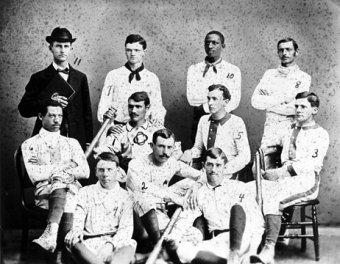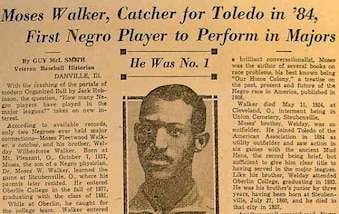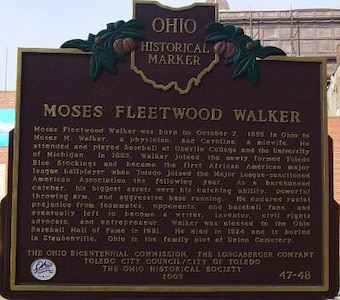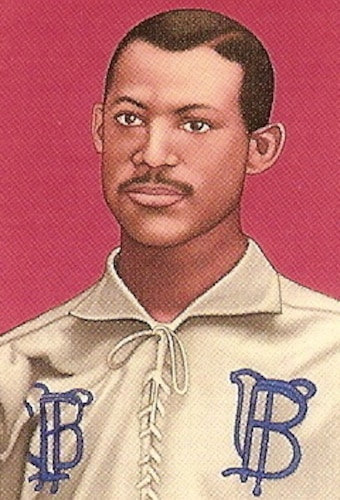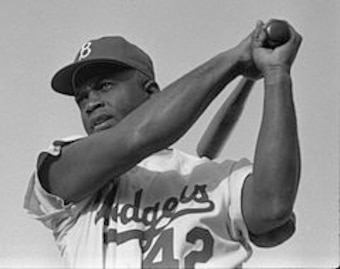Moses Fleetwood "Fleet" Walker (October 7, 1856 – May 11, 1924) was an American baseball player, inventor, and author. He is credited by some with being the first African American to play Major League Baseball.[1] Walker played one season as the catcher of the Toledo Blue Stockings, a club in the American Association. He then played in the minor leagues until 1889, when professional baseball erected a color barrier that stood for nearly 60 years. After leaving baseball, Walker became a businessman and advocate of Black nationalism.
Contents
[hide]Early life[edit]
Walker was born in Mount Pleasant, Ohio, the son of Dr. Moses W. Walker, the first African-American physician in Mount Pleasant, and his Caucasian wife. During his childhood, his family moved from Mount Pleasant, to Steubenville. Walker was educated in the black schools, until the schools in Steubenville were integrated. Both Moses and his brother Weldy attended Steubenville High School. He enrolled in Oberlin College in 1878 and played on the college's first varsity baseball team in the spring of 1881. Walker was a star catcher for Oberlin.[2]
Collegiate baseball[edit]
He was recruited by the University of Michigan and played varsity baseball for Michigan in 1882. On March 4, 1882, the University of Michigan student newspaper, The Chronicle, reported: "M.F. Walker, of the class of '83 at Oberlin, arrived in town last week, and intends to enter the University. Mr. Walker caught for the Oberlin baseball team, and last year corresponded with the manager of the Bostons with a view to traveling with the latter nine during the summer, but at length concluded not to do so. Packard and Walker will form the battery for '83's nine this spring."[3]
While attending Michigan, Walker was able to play for the White Sewing Machine Club, based in Cleveland, Ohio.[2] It was here that the young Walker experienced his first mistreatment based on his skin color. While the players dined at the St. Cloud Hotel in Kentucky, Walker was refused service because he was black. Things would get worse when the game was played, as the opposing team refused to take the field when Walker was installed at catcher. Walker was pulled, but his replacement was a mediocre player who could not handle the pitches thrown to him. When the crowd began to chant for Walker to play, the opposing team's owner begrudgingly allowed the Cleveland team to insert Walker.[2]
During the season immediately prior to Walker's debut, Michigan's play was terrible, with catching being the sore part of the team. It was so terrible, that Michigan would recruit semi-pro players to play catcher for the bigger games. In 1882, Walker had an amazing season for Michigan. Michigan went 10–3, with Walker batting second in the lineup. He is credited as batting .308 for the season.
Minor leagues[edit]
Walker signed with a minor league team, the Toledo Blue Stockings of the Northwestern League in 1883. At the time few catchers wore any equipment, including gloves. Walker had his first encounter with Cap Anson that year, when Toledo played an exhibition game against the Chicago White Stockings on August 10. Anson refused to play with Walker on the field. However, Anson did not know that on that day Walker was slated to have a rest day. Manager Charlie Morton played Walker, and told Anson the White Stockings would forfeit the gate receipts if they refused to play. Anson then agreed to play.[4]
Major leagues[edit]
In 1884 Toledo joined the American Association, which was a Major League at that time in competition with the National League. Walker made his Major League debut on May 1 against the Louisville Eclipse. In his debut, he went hitless and had four errors.[1] In 42 games, Walker had a batting average of .263, which was above the league average. His brother, Weldy Walker, later joined him on the team, playing in six games. The Walker brothers are the first known African Americans to play baseball in the Major Leagues.
Walker's teammate and star pitcher, Tony Mullane, stated Walker "was the best catcher I ever worked with, but I disliked a Negro and whenever I had to pitch to him I used to pitch anything I wanted without looking at his signals."[5] Mullane's view hurt the team, as there were a number of passed balls and several injuries suffered by Walker, including a broken rib.[2]
Return to minors[edit]
Walker suffered a season-ending injury in July, and Toledo folded at the end of the year. Walker returned to the minor leagues in 1885, and played in the Western League for Cleveland, which folded in June. He then played for Waterbury in the Eastern League through 1886.
In 1887 Walker moved to the International League's Newark Little Giants. He caught for star pitcher George Stovey, forming the first known African-American battery. On July 14, the Chicago White Stockings played an exhibition game against the Little Giants. Contrary to some modern-day writers, Anson did not have a second encounter with Walker that day (Walker was apparently injured, having last played on July 11, and did not play again until July 26). But Stovey had been listed as the game's scheduled starting pitcher, in the Newark News of July 14. Only days after the game was it reported (in the Newark Sunday Call) that, "Stovey was expected to pitch in the Chicago game. It was announced on the ground (i.e., "at the ballpark") that he was sulking, but it has since been given out that Anson objected to a colored man playing. If this be true, and the crowd had known it, Mr. Anson would have received hisses instead of the applause that was given him when he first stepped to the bat." On the morning of that same, International League owners had voted 6-to-4 to exclude African-American players from future contracts.[4][6]
Color line drawn[edit]
In the off-season, the International League modified its ban on black players, and Walker signed with the Syracuse, New York, franchise for 1888, the Syracuse Stars. In September 1888, Walker had his second incident with Anson. When Chicago was at Syracuse for an exhibition game, Anson refused to start the game when he saw Walker's name on the scorecard as catcher. "Big Anson at once refused to play the game with Walker behind the bat on account of the Star catcher's color," the Syracuse Herald said. Syracuse relented and someone else did the catching.[7]
Walker remained in Syracuse until the team released him in August 1889.[8] Shortly thereafter, the American Association and the National League both unofficially banned African-American players, making the adoption of Jim Crow in baseball complete. Baseball would remain segregated until 1946 when Jackie Robinson "broke the color barrier" in professional baseball playing for the Brooklyn Dodgers' minor league affiliate in Montreal.
Post-baseball life[edit]
Business owner and inventor[edit]
In 1891, Walker was out of professional baseball, but he was not suffering by not playing the game. Walker purchased the Union Hotel in Steubenville. Seeing that moving pictures could be very popular, Walker bought a theater in nearby Cadiz. Walker applied for patents on several inventions for moving-picture equipment and even published a weekly newspaper.[9] Also in 1891, Walker received patents for an explodingartillery shell.[10]
Murder acquittal[edit]
Walker was attacked by a group of white men in Syracuse, New York, in April 1891. He stabbed and killed a man named Patrick Murray during the attack. The Sporting Life reported "Walker drew a knife and made a stroke at his assailant. The knife entered Murray's groin, inflicting a fatal wound. Murray's friends started after Walker with shouts of 'Kill him! Kill him!' He escaped but was captured by the police, and [was] locked up."[11]
Walker was charged with second-degree murder and claimed self-defense. He was acquitted of all charges on June 3, 1891. Adding to the weight of the verdict, was that Walker was acquitted by an all-white jury.[9]The Cleveland Gazette reported "When the verdict was announced the court house was thronged with spectators, who received it with a tremendous roar of cheers... Walker is the hero of the hour."[12]
Politics[edit]
Walker became a supporter of Black nationalism and came to believe that racial integration would fail in the United States. In 1908 he published a 47-page pamphlet titled Our Home Colony: A Treatise on the Past, Present, and Future of the Negro Race in America. In that pamphlet he recommended that African Americans emigrate to Africa: "the only practical and permanent solution of the present and future race troubles in the United States is entire separation by emigration of the Negro from America."[13] He warned "The Negro race will be a menace and the source of discontent as long as it remains in large numbers in the United States. The time is growing very near when the whites of the United States must either settle this problem by deportation, or else be willing to accept a reign of terror such as the world has never seen in a civilized country."[11]
Death[edit]
He died on May 11, 1924, in Cleveland, Ohio, and is interred at Union Cemetery in Steubenville, Ohio.[14]
Legacy[edit]
Walker has traditionally been credited as the first African-American major league player. However, research in the early 21st century by the Society for American Baseball Research indicates William Edward White, who played one game for the Providence Grays in 1879, may have been the first.[15]
_________________________________________________________________________________



